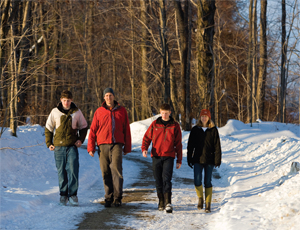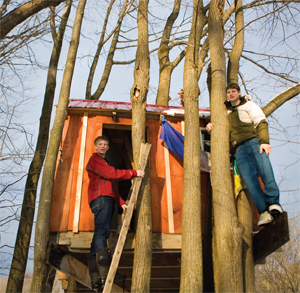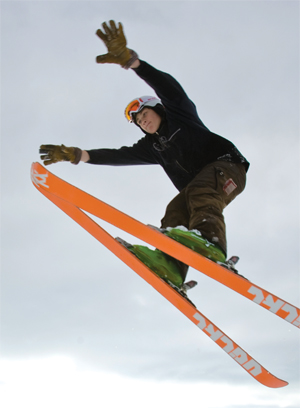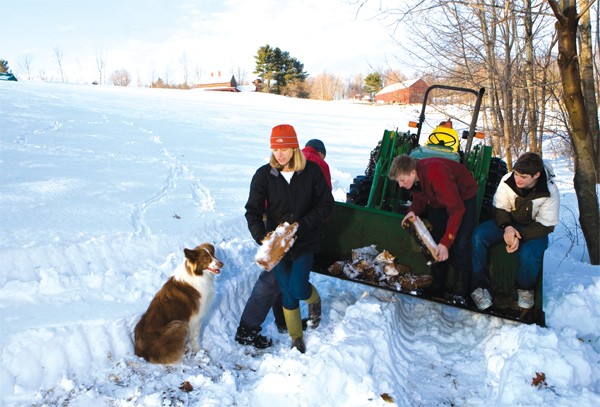Sheldon and Penelope Pennoyer will tell you they moved to their hilltop land in Greenfield, New Hampshire, because they wanted their boys to do farm chores. Back when their first child was born, Sheldon announced, “Well, we might as well get some cows, too.” Most of us with a new baby on board wouldn’t be looking to add farm chores to our to-do list. But Sheldon Pennoyer grew up on his family’s land, and those memories – and lessons learned in the outdoors – have stayed with him.
Nowadays, their two boys are in charge of the family’s livestock. Pier, age 17, takes care of the milk cow, her calves, and the chickens. Chase, age 14, looks after the flock of sheep. Everyone helps with cutting firewood, haying, lambing, mending fences, weeding the garden, and maintaining the trail network in the woods. Now that the boys are in their teens, they still do their chores, but they’re more interested in other outdoor activities such as skiing, mountain biking, and school sports. Pier made a video with some of his friends who share his love of skiing. It’s a ski movie, but it’s filmed in the middle of summer, at a local sand pit. The boys are wearing old ski equipment, and they’re filmed climbing through the forest with their skis on their shoulders, then “skiing” down the sand slopes. They cheer each other on, encouraging ever more spectacular flips and falls, sand flying in every direction. These boys know how to have fun in the woods.
The life of the Pennoyer boys seems refreshing, given the rising concern in today’s culture about the loss of connection between kids and nature, as highlighted in Richard Louv’s best-selling book Last Child in the Woods: Saving our Children from Nature-Deficit Disorder.

Chase, Sheldon, Pier, and Penelope
For the Pennoyer family, the desire to give their boys a life in the out-of-doors was a driving force behind their decision to move to Greenfield in 2000. Sheldon is an architect, with a firm in Massachusetts where Penelope also manages the office. Despite busy careers, their passion is clearly the family life they’ve built around their property at the end of a dirt road: “We’ve never had to provide something for the boys to do,” says Penelope. “They’ve come up with it themselves.” When they were younger, the boys played in dirt piles, built forts, and caught frogs. These days, Chase has been constructing a network of mountain-bike trails in the woods, complete with ramps and jumps that catapult him through the trees at breakneck speeds. When asked about the safety of this endeavor, Sheldon responds, “I actually think dangerous is good. I love to see them out in nature, learning to take risks….and they have to do the work, build the trails, get covered in poison ivy, and then they have to pedal the bike! It’s work, but it’s also a thrill for them.”
The Pennoyers’ focus on the outdoors, according to Louv’s book, is an increasingly rare approach to parenting. More often, children are in scheduled activities, or playing indoors, or connected to technology and computers. The Pennoyers have managed to buck this trend.
Their 140 acres sits on the side of Blanchard Hill, a scenic slope overlooking Mt. Monadnock to the south. When the Pennoyers bought the property, it included 20 acres of hayfields and 10 acres of pasture that had somehow stayed open though the rest of the property had reverted to forest over time. While the Pennoyers recognized the value of the fields for hay, they sought advice when it came to understanding what the forestland held in store. Right away, they commissioned a forest management plan from forester Ron Klemarczyk and discussed with him their vision for using the forest resources on the land. They welcomed the idea of sustainable timber harvests, but they also placed a high value on recreation, wildlife habitat, watershed protection, and preservation of such historic features as cellar holes and stone walls.
Their first timber harvest in 2002 helped make the woods their own, though the Pennoyers aren’t bashful about noting that income from the sale also helped pay for a new septic system. They harvested almost 170,000 board feet of timber – mostly pine and some red oak – from stands covering 70 acres. They also needed to invest in a new series of woods roads to haul the timber, and as a result, the Pennoyers netted an excellent set of trails that they – and their community – now use for running, walking, hunting, mountain biking, and cross-country skiing. Sheldon takes pleasure in continuing to work on the trails, removing trees to open up the trails to sunlight and views. The broad, easy-to-follow trails make the difference between a family confined to open areas around the house and one with easy access to the entire property, including a special grove of large red oaks, a quiet brook that runs down the back side of the hill, and a “cross-country” trail connection across Blanchard Hill to properties owned by several neighbors.

One of those neighbors, Jeff Timmons, introduced Sheldon to a volunteer program – the New Hampshire Coverts Project – that provides training on wildlife ecology and habitat management. Since then, the two families have shared ideas and efforts in managing their combined lands for wildlife. Although the Pennoyers manage most of their fields for high-quality hay (they get at least two hay crops per summer), they also are concerned about wildlife such as grassland-nesting birds, whose nests and offspring may be disturbed or destroyed by haying before mid-July. On several fields, the Pennoyers are using rotational grazing, with different fields being grazed by different animals at different times. This creates a mosaic of grass heights and plant structures, which will be used by such species as killdeer, meadowlarks, and bluebirds. Working with the Timmons, the Pennoyers are also managing several large meadows specifically for wildlife. The fields are on the Timmons’ property, but the Pennoyers do the mowing. They are experimenting with a longer mowing rotation – about every two years – which is enough to keep shrubs from invading while creating a diverse mix of grasses and wildflowers. This type of “old field” habitat will be used by such species as ruffed grouse, American kestrels, turkeys, rabbits, and deer.
Sheldon describes the phone conversation he had with Timmons, when they were first considering purchasing the Blanchard Hill property. “When I talked to Jeff, and heard about his attitude towards their property, I knew this was the right place,” says Sheldon. They had originally heard about the land from Sheldon’s cousin, Monica, who lived on the other side of Blanchard Hill. In talking with Jeff, he found that all three families felt strongly about conserving their lands for the future. Shortly after they purchased their property, the Pennoyers donated a conservation easement on their land to the Monadnock Conservancy, a regional land trust. Jeff and Sarah Timmons and Monica and her husband, Michael Lehner, also donated easements at the same time. Combined, their properties cover almost 1,000 acres of permanently protected land overlooking Mount Monadnock and Crotched Mountain. Jeff Timmons is fond of saying that the three families have “a property without borders.” Theirs was the first step in an effort they named “Keeping the Green in Greenfield.” The families continue to reach out to other neighbors, and Sheldon has since joined the board of the Monadnock Conservancy.
Interest in land conservation runs deep in both Penelope’s and Sheldon’s families. Penelope was raised in Lincoln, Massachusetts, where publicly owned conservation lands form a strong network throughout the town. She remembers a town meeting in the late 1970s, where she witnessed a man who had donated the last piece of his family’s land to the town for conservation. “He stayed after the meeting as we all filed out,” she says. “You could tell what an important moment this was for him. They weren’t a wealthy family, but they cared deeply about the community where their family had lived for hundreds of years. I’ve never forgotten that moment.”
Conservation also influenced Sheldon’s childhood. He was raised on New York’s Long Island, on land that had been permanently protected by his parents in the 1970s. “They conserved it partly to prevent a large bridge from being built across [Long Island] Sound,” but the result has been that they are still farming the property in the midst of vast suburban sprawl. His 87-year-old father still splits firewood that he cuts on their land, a tradition that has disappeared all around him. Sheldon recognizes that permanent land conservation is what made his childhood possible, complete with woods work, semi-tame raccoons roaming the house, and, of course, farm chores.

The Pennoyers’ search for a way of life in New Hampshire wasn’t just about finding the right piece of land, although they admit the hayfields and the mountain views sealed the deal. “We wanted a strong community, but it’s hard to find community at the end of a dirt road,” says Sheldon. They went in search of it. He joined the planning board, and with kids in the local schools, they got involved in youth activities. And they kept their land open. “One of the big reasons the locals resent newcomers is when new owners decide to close their forestland to hunting,” says Sheldon. “People who don’t hunt may not realize that when land is closed to hunters, whole family traditions can be lost. We’ve found that hunters are very respectful…it’s gratifying to have them tell us how appreciative they are of our trails and woods.” Keeping their land open to others is a way of inviting the community to visit the end of the dirt road. And although Sheldon hunts deer in the fall, he usually avoids his own property. “I don’t do well hunting here…I get too distracted, noticing all the things that need doing.”
The Pennoyers do virtually all of the work on the land themselves. “Nothing draws a family together,” says Penelope, “like trying to get the hay in before it rains.” They heat with wood, cut and hauled out from their woodlands by tractor. Their forest management plan details where the forest should be thinned of low-grade wood, so the Pennoyers are improving their forest at the same time that they’re heating their home. Most mornings, Sheldon splits wood before work. At the end of the day, the Pennoyers return home to weed the garden, cut hay, fix stone walls, or cut wood. “Farming and working the land are Sheldon’s passions,” explains Penelope. To which he responds, “That passion is what has shaped our life here. It’s actually a relief to me to work outside on the weekends. I won’t come in all day – completely forget about lunch – I just love it.”
Sheldon’s enthusiasm hasn’t waned, but they do laugh about their kids. The Pennoyers share the story of one morning, when Pier was milking. The boy turned to his visiting grandfather, who had come to fetch the milk, and said, “You know, when I grow up, I’m going to live in a city.” His parents are fine with that, knowing that the life lessons and skills the boys have developed on the land will serve them well, no matter where they end up.
One of those life lessons is growing much of the food they eat. The animals they raise provide them with beef, lamb, and chicken, along with milk, cream, and eggs. Sheldon says the family truly values their food and fuel, since they all recognize how much work goes into getting it to the table or the woodstove: “It’s not just having a garden, it’s choosing what to grow, then planting, weeding, and finally harvesting…it all takes little pieces of your time.” The house they live in, a refurbished version of the original 1790s farmhouse, also reflects serious work. Back in 2000, they spent a whirlwind five months taking the falling-down structure apart and putting it back together again. They tell tales of tiling the kitchen floor at midnight: “It’s [from going to] architecture school,” explains Sheldon. “You pull all-nighters for years and years. You get used to staying up all night working.” Somehow, the kitchen tiles are straight and level.
Living at the end of the road has made a big mark on all of the Pennoyers. At age eight, Chase wrote in a school essay: “I love the woods because I love the smell and there can be secrets like new things that I haven’t seen.” Families like the Pennoyers are showing that this doesn’t have to be the last generation of children in the woods.



Discussion *